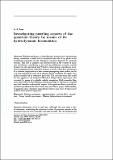Por favor, use este identificador para citar o enlazar a este item:
http://hdl.handle.net/10261/130413COMPARTIR / EXPORTAR:
 SHARE
BASE SHARE
BASE
|
|
| Visualizar otros formatos: MARC | Dublin Core | RDF | ORE | MODS | METS | DIDL | DATACITE | |

| Campo DC | Valor | Lengua/Idioma |
|---|---|---|
| dc.contributor.author | Sanz, Ángel S. | - |
| dc.date.issued | 2015-05-21 | - |
| dc.identifier | doi: 10.1007/s10701-015-9917-2 | - |
| dc.identifier | issn: 0015-9018 | - |
| dc.identifier.citation | Foundations of Physics 45: 1153- 1165 (2015) | - |
| dc.identifier.uri | http://hdl.handle.net/10261/130413 | - |
| dc.description | 13 págs.; 4 figs. | - |
| dc.description.abstract | © 2015, Springer Science+Business Media New York. Bohmian mechanics, a hydrodynamic formulation of the quantum theory, constitutes a useful tool to understand the role of the phase as the mechanism responsible for the dynamical evolution displayed by quantum systems. This role is analyzed and discussed here in the context of quantum interference, considering to this end two well-known scenarios, namely Young’s two-slit experiment and Wheeler’s delayed choice experiment. A numerical implementation of the first scenario is used to show how interference in a coherent superposition of two counter-propagating wave packets can be seen and explained in terms of an effective model consisting of a single wave packet scattered off an attractive hard wall. The outcomes from this model are then applied to the analysis of Wheeler’s delayed choice experiment, also recreated by means of a reliable realistic simulation. Both examples illustrate quite well how the Bohmian formulation helps to explain in a natural way (and therefore to demystify) aspects of the quantum theory typically regarded as paradoxical. In other words, they show that a proper understanding of quantum phase dynamics immediately removes any trace of unnecessary artificial wave-particle arguments. | - |
| dc.description.sponsorship | The author acknowledges support from the Ministerio de Economía y Competitividad (Spain) under Project No. FIS2011-29596-C02-01 as well as a “Ramón y Cajal” Research Fellowship with Ref. RYC-2010-05768 | - |
| dc.publisher | Springer Nature | - |
| dc.relation | MINECO/FIS2011-29596-C02-01 | - |
| dc.relation.isversionof | Preprint | - |
| dc.rights | openAccess | - |
| dc.subject | Bohmian mechanics | - |
| dc.subject | Velocity field | - |
| dc.subject | Interference | - |
| dc.subject | Wheeler delayed-choice experiment | - |
| dc.subject | Young two-slit experiment | - |
| dc.subject | Quantum phase | - |
| dc.title | Investigating puzzling aspects of the quantum theory by means of its hydrodynamic formulation | - |
| dc.type | preprint | - |
| dc.identifier.doi | 10.1007/s10701-015-9917-2 | - |
| dc.relation.publisherversion | http://dx.doi.org/10.1007/s10701-015-9917-2 | - |
| dc.date.updated | 2016-03-23T12:53:23Z | - |
| dc.description.version | Peer Reviewed | - |
| dc.language.rfc3066 | eng | - |
| dc.contributor.funder | Ministerio de Economía y Competitividad (España) | - |
| dc.relation.csic | Sí | - |
| dc.identifier.funder | http://dx.doi.org/10.13039/501100003329 | es_ES |
| dc.type.coar | http://purl.org/coar/resource_type/c_816b | es_ES |
| item.openairetype | preprint | - |
| item.grantfulltext | open | - |
| item.cerifentitytype | Publications | - |
| item.openairecristype | http://purl.org/coar/resource_type/c_816b | - |
| item.fulltext | With Fulltext | - |
| Aparece en las colecciones: | (CFMAC-IFF) Artículos | |
Ficheros en este ítem:
| Fichero | Descripción | Tamaño | Formato | |
|---|---|---|---|---|
| Investigating.pdf | 2,81 MB | Adobe PDF |  Visualizar/Abrir |
CORE Recommender
Page view(s)
205
checked on 19-abr-2024
Download(s)
289
checked on 19-abr-2024
Google ScholarTM
Check
Altmetric
Altmetric
NOTA: Los ítems de Digital.CSIC están protegidos por copyright, con todos los derechos reservados, a menos que se indique lo contrario.
